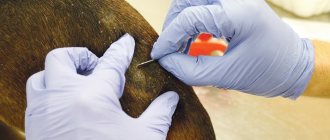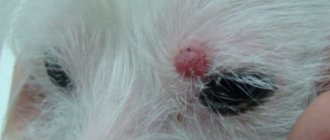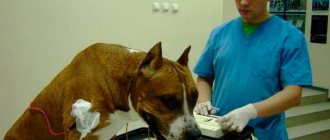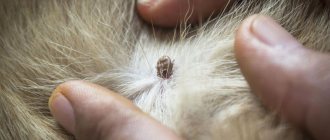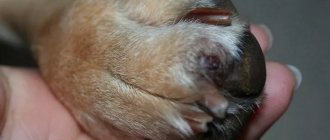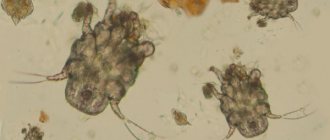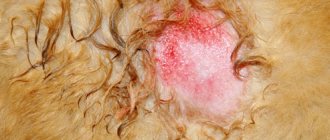Causes and routes of infection
The cause of scabies is the scabies mite, a skin parasite that lives in the skin, gnawing passages in it and laying its eggs there. At the same time, the tick introduces various microorganisms into the skin, which leads to inflammation.
Normally, the dog’s immune system itself controls the population of parasites and prevents them from multiplying. But as soon as immunity decreases, the number of ticks begins to increase, and the disease progresses. Scratching itchy areas of the skin leads to inflammation, damage, and subsequently infection. It is important to identify scabies in your dog as early as possible and treat it.
All types of scabies, which are caused by mites, have superficially similar symptoms with some differences in detail. Parasites penetrate the epidermis of the animal and begin to feed on tissue fluids. Some specimens make passages, spreading their habitat throughout the body. The peak of scabies mite infestation occurs in the autumn-winter period.
A dog can become infected with the causative agent of scabies through contact with a sick animal, as well as without it. Scabies mites can live on other surfaces for about 2 weeks until they land on the body of a new host. The place of their temporary localization can be grass, soil, shoes or human clothing. Often domestic dogs become infected from strays while walking outside.
There is no specific predisposition to infection in dogs of a particular breed or age. But scabies mites are especially dangerous for puppies with an undeveloped immune system, and for dogs whose immune system is weakened. The development of scabies is promoted by:
- poor nutrition;
- insufficient hygienic care;
- past infections;
- chronic diseases;
- stress;
- helminthiasis;
- taking antibiotics.
Danger of infection for humans
The scabies mite will feel great in the body of any warm-blooded creature, so it is quite possible to become infected with it from an animal.
The scabies mite is very contagious, so the owner can easily pick up the disease from his pet.
The first signs of parasite infestations appear after 15-20 days, therefore, having noticed symptoms of scabies in a pet, the owner should take preventive measures:
- Treat all objects in the house with disinfectants, since scabies mites could linger on any of them.
- Treat upholstered furniture with a steamer or iron it.
- Wash the dog's bed and wash the toys in boiling water and soap.
- The brush you used to brush your dog should be changed!
Attention. A dog with scabies must be isolated in a separate corner of the room, but leaving the dog alone is contraindicated. The pet needs to buy new toys, try to maintain a good mood, and reward it with treats after treatment procedures.
Types and symptoms of scabies
Scabies can be caused by several types of mites. All parasites are microscopic in size. Each of them corresponds to its own type of scabies :
- Sarcoptes canis (sarcoptosis);
- Otodectes cynotis (otodectosis - ear scabies);
- Notoedres cati (notoedrosis);
- Cheyletiella yasguri (cheyletiosis);
- Demodex canis (demodex)
You can suspect that a dog has scabies based on certain signs:
- itching;
- skin irritation;
- crust formation;
- partial alopecia (pathological hair loss, leading to its partial or complete disappearance in certain areas of the head or torso).
On a note! Regardless of the pathogen, all types of scabies cause itching, but its severity may vary. For example, with sarcoptic mange it is very strong, but with demodicosis it increases gradually; the dog may not feel discomfort for some time.
Sarcoptic mange
The causative agent of the disease Sarcoptes canis penetrates deep into the epidermis, making passages in it. Most of all, the tick likes to settle in places covered with short hairs (ears, head, nose, bends of the joints of the limbs). First, an inconspicuous dot appears on the animal’s body. After about 10 days, itchy ulcerative areas form in its place.
Signs of sarcoptic mange:
- the dog is restless, it is constantly itching and fussing;
- severe itching;
- bloody discharge at scratching sites;
- crusts around injured skin;
- profuse dandruff on the affected skin.
When the animal's ears are touched, the hind limbs twitch. This reaction occurs precisely when Sarcoptes canis is parasitized.
Cheyletiosis
One of the most contagious forms of scabies, which is also called wandering scabies. Cheyletiella yasguri lives on the surface of the skin, feeding on its dead cells and tissue fluid. Most often, parasites can be found along the spine, on the neck and ears.
Characteristic signs of cheyletiosis:
- local hair loss in patches;
- large dandruff in certain areas;
- inflammation of the skin, infection in areas of scratching;
- scab-like crusts.
Otodectosis (ear scabies)
This disease is often detected in lop-eared dogs. Droopy ears are a favorable breeding ground for Otodectes cynotis mites.
Symptoms of otodectosis:
- the dog constantly tilts its head towards the affected ear;
- rubs the ear against any objects;
- bleeding wounds appear that can become infected;
- sticky dark mass in the ears with an unpleasant odor - waste from the life of parasites.
Due to damage not only to the external auditory canal, but also to the inner ear, the animal may become deaf.
Read more: Ear scabies in dogs, signs, causes, treatment and prevention.
Notoedrosis
Notoedres cati parasitizes in the deep layers of the skin, causing severe itching. The tick's movement speed is quite high, so it is considered very contagious. Notoedrosis is characterized by the appearance of blisters on the surface of the skin. Most often these are the ears, nose, head, brow ridges. Without treatment, progression of the disease leads to hair loss in problem areas and the appearance of folds on the skin.
Demodicosis
The Demodex canis mite causes demodicosis in dogs and lives on the skin of most healthy animals. Against the background of decreased immunity, it begins to actively reproduce. Habitat: hair follicles or skin surface. Demodectic mange can be identified by its characteristic symptoms:
- itching of varying intensity (with a localized form - weak, with a generalized form - intensifying);
- severe redness of the skin;
- the presence of scales in problem areas;
- alopecia;
- hard crusts on the lesions;
- bleeding ulcers.
Characteristics of the pathogen
Adult female mites live in the skin. There they lay eggs, which mature in three to four days. From the moment of laying to the appearance of a new parasite, only ten days pass. Larvae and adult mites often invade hair follicles and sebaceous glands, causing hyperkeratosis and thickening of the epidermis. As we have already said, the first symptoms appear on the face, from there the parasite quickly spreads to the ears, lower jaw and neck. In some animals, the disease is especially severe, as the tick affects the lower abdomen and groin area.
Difference between scabies and other skin diseases
The symptoms of scabies are very similar to other dermatological pathologies; it is almost impossible to make a diagnosis on your own. Allergic eczema has the most external manifestations with scabies. A distinctive feature of an allergic reaction is the absence of scabs and crusts, and there is no release of adhesive exudate. The skin only becomes inflamed and hyperemic.
It is also worth distinguishing scabies from hormonal disorders due to adrenal dysfunction, which also causes hair loss. In such cases, it is necessary to conduct a blood test for hormones.
How dangerous is the disease?
Itching mites are aggressive creatures that will not leave their host without special treatment. The longer they stay in the body, the more significant harm they cause to dog health:
- Decreased immunity. A constantly itchy dog loses its appetite and interest in life. As a result, the resulting exhaustion has a bad effect on the immune system.
- Intoxication. As ticks multiply, the products of their vital activity accumulate in the body. They enter the blood, which leads to intoxication of the entire body.
- Penetration of infections. By scratching its skin, the animal inflicts wounds and scratches on itself, creating an entry point for various infectious diseases.
- Pathogenic microflora. Inflammation of skin areas provokes the occurrence of dermatitis. Areas of irritation become crusty, disrupting skin heat exchange and oxygen penetration. This creates conditions for the proliferation of pyogenic bacteria, staphylococcus, streptococcus.
As a result of these factors, the dog’s cardiovascular and nervous system is disrupted, which leads to the development of side pathologies.
Treatment of scabies
Getting rid of subcutaneous mites is a long process. Recovery is influenced by various factors: the type of parasite and the form of scabies, the degree of skin damage, the age of the dog, and its immune status. Therapy requires an integrated approach. It is necessary not only to use external, but also systemic drugs.
General rules
For treatment to be as effective as possible, you need to adhere to certain rules :
- isolate the dog;
- disinfect the room where the pet is located with insecticides;
- change the bedding daily, steam it or wash it in hot water;
- Treat the dog's skin with gloves;
- To avoid stress for your pet, it is recommended to limit the number of guests in the house during treatment.
Stages of therapy
For an effective result, you need to adhere to a certain sequence of treatment measures:
- Trim the fur in areas affected by ticks.
- Bathe your dog with a special antibacterial shampoo.
- Apply antiparasitic drugs (Bars drops, Amidel gel) to the skin, strictly following the instructions. After 2-3 weeks, repeat the procedure.
- Treat skin wounds with antiseptics to avoid infection.
- To speed up the regeneration of damaged skin, wound healing ointments are applied.
- For systemic exposure, injections are made with drugs based on organochlorine or organophosphorus compounds.
- In advanced cases, when a secondary infection occurs, antibiotics are prescribed.
Medicines for scabies
The veterinarian selects medications for scabies taking into account the development cycle of the parasites and their resistance to active substances. Antiparasitic ointments, sprays, drops are used externally. It is recommended to treat the dog’s skin with the preparations three times, at intervals of a week. This will make it possible to destroy the maximum number of parasites.
Drops against subcutaneous mites are considered more effective
- Leopard;
- Surolan;
- Stronghold.
One of the most effective external remedies for scabies in the initial stages is Amidel gel . This is a complex drug, the active ingredients of which have antiparasitic, antiseptic, anesthetic effects, relieve itching, soften the skin, and facilitate the removal of crusts.
As an aid to speed up regeneration, the dog's skin is treated with ointments:
- Levomekol;
- Solcoseryl.
For systemic use, preparations based on organochlorine and organophosphorus compounds are effective:
- Ivermectin;
- Aversect;
- Amitraz;
- Permethrin.
Possible complications
The spread of scabies mites leads to a significant deterioration in the dog's condition. Due to severe itching, she cannot sleep, play, walk, eat, and is constantly itching. The growth of the parasite population leads to an increase in their waste products, which are very toxic. They enter the bloodstream and cause intoxication.
The appearance of crusts on damaged areas prevents the passage of air. This leads to the active proliferation of bacteria, resulting in the formation of purulent foci of infection that penetrate deeper into the skin. Such complications can only be avoided with timely diagnosis of scabies and an integrated approach to treatment. It is recommended to regularly examine the dog and consult a doctor if there are any suspicious changes.
How to treat
Treatment for sarcoptic mange is carried out at home. But a sick pet must be isolated from household members and other animals. It is mandatory to treat dog accessories and items in the house with disinfectants (2% chlorophos solution).
Step-by-step algorithm on how to treat a dog for scabies mites:
- bathe thoroughly and wash your pet in warm water using aniseboric shampoo or tar or baby soap. This will help clear away scabs from your skin. dandruff, sebaceous discharge;
- at the end of bathing, rinse with a solution of calendula, string or chamomile;
- to avoid hypothermia, dry the animal thoroughly;
- shave the affected areas or cut them as short as possible;
- To prevent the dog from licking the medicine, put a collar on it;
- Apply the medication prescribed by your veterinarian to the wounds. Depending on the instructions, treatment is carried out 3–5 times with an interval of 5–10 days.
Duration of treatment – 6 weeks.
Drugs for the treatment of sarcoptic mange:
- Apoquel tablets, Glucocortican tablets, and Skinmed shampoo containing chlorhexidine will help relieve itching;
- antiparasitic drops “Stronghold”, “Advocate”, “Frontline”, “Advantage”;
- tablets "Bravecto", "Simparico";
- solutions of hyposulfite, benzyl benzoate, hexachlorane emulsion, ASD-3;
- antimicrobial ointments Konkov, Vishnevsky, tetracycline, sulfur, tar;
- injections with ivermectin.
Antiparasitic therapy is complemented by sedatives, antiallergic agents, and hepatoprotectors. The dosage and treatment regimen are prescribed by the veterinarian depending on the breed, weight, and age of the dog.
Prevention of scabies in dogs
It is impossible to completely protect an animal from infection with scabies mites. To reduce the risk of active parasitism on the body, it is recommended:
- Avoid walking in areas where there are stray dogs.
- Do regular wet cleaning with disinfectants in the room where the dog lives.
- Regularly treat your dog for fleas, ticks and worms. Provide rational and balanced nutrition.
Scabies in dogs is an unpleasant phenomenon that causes a lot of inconvenience. If you identify the problem in a timely manner and strictly follow the veterinarian’s recommendations for eliminating it, then it responds well to treatment. To avoid relapses of scabies, it is recommended to strengthen your pet’s immune system.
Therapeutic measures
How is notoedrosis treated in a dog? Firstly, the sick dog is isolated both from other animals and from humans. Before starting treatment, be sure to wash the dog using special shampoos designed to soften the scabs that have formed on its skin. The areas of the body that have been cleared of crusts are treated with ointments containing sulfur compounds. As a rule, various insecticidal preparations are used for the same purposes.
Important! Under no circumstances prescribe such medications yourself, as their overdose can lead to serious consequences for the animal’s body.
Aversectin ointment has proven itself well, as well as aqueous solutions of neocidol, stomozan, butox and other products that your veterinarian will prescribe. As a rule, they are used once, weekly. The duration of the course of therapy depends on the condition of the animal and the general development of the pathology. A decision to stop treatment is possible only after several microscopic examinations of scrapings from the skin of the ears. Most often, timely treatment begins to help get rid of the tick relatively quickly.
Development of the disease
At the first stage, redness appears on the skin and the pet begins to itch. Unfortunately, at this stage, owners do not pay attention to the symptoms and do not even suspect the presence of the disease. After all, it is quite normal for a dog to scratch itself and there is no reason to immediately examine the skin and suspect a problem.
Next, small red dots called pustules begin to appear on the skin. They are filled with liquid and when the animal itches they burst. In places of pathological foci, hair begins to fall out, and the skin becomes very rough. Rejected skin particles also appear, they are very similar to dandruff.
The skin condition worsens, loses elasticity and becomes rougher. Moreover, when such areas are scratched, the skin cracks and bloody cracks appear. The condition of the coat also deteriorates significantly; in the affected areas it falls out intensively, and in other areas it becomes dull. The dog refuses to eat and begins to lose a lot of weight.
Quite often other infectious diseases develop, which significantly complicates the general condition. It is worth saying that only a specialist can diagnose the disease after examination. Everyone experiences the disease differently, and symptoms may vary.
